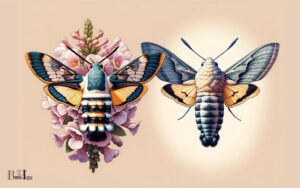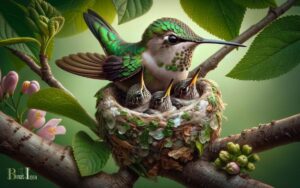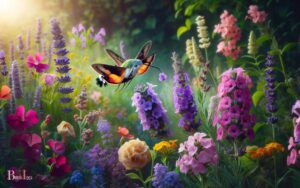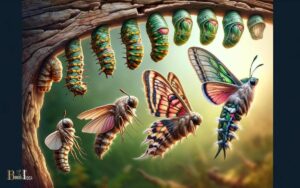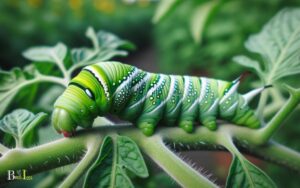Hummingbird Moth Caterpillar Host Plant: Hawthorn, Snowberry
The hummingbird moth caterpillar thrives on a variety of host plants, which are crucial for their survival and development into adult moths. Key host plants include honeysuckle, snowberry, hawthorn, and viburnum.
Gardeners looking to attract and support hummingbird moth populations should cultivate these plants to provide the necessary nourishment and habitat for the caterpillars.
Hummingbird moth caterpillars depend on specific host plants for food and habitat. The choice of plant can vary depending on the species of hummingbird moth.
For example:
Choosing the right host plants is essential for the caterpillars to receive adequate nutrition and to complete their life cycle successfully.
Cultivate a hummingbird moth haven by planting their preferred host plants in your garden.

Key Takeaway
Identifying Hummingbird Moth Caterpillars
The caterpillars of hummingbird moths can be identified by their distinctive green coloration and the presence of diagonal white stripes along their bodies.
These caterpillars are often found on their host plants, such as honeysuckle, hawthorn, and snowberry. When fully grown, they can reach a length of about 2 inches.
Their green color helps them blend in with the leaves, providing a form of camouflage from predators.
The white stripes serve as a warning signal to potential predators, indicating that the caterpillars aren’t suitable for consumption. This combination of coloration and markings is an adaptation that aids in their survival.
Characteristics of Hummingbird Moth Caterpillars
Hummingbird moth caterpillars exhibit unique feeding habits, physical appearances, and sizes compared to other caterpillar species.
Their feeding habits include a preference for specific host plants, and their physical appearance can vary in color and markings.
Understanding their characteristics, such as their preferred host plants, is essential for identifying and nurturing these fascinating creatures.
Caterpillar Feeding Habits
During the larval stage, hummingbird moth caterpillars primarily feed on the leaves of their host plants, exhibiting voracious appetites and rapid growth.
These caterpillars are known for their distinctive feeding habits, often consuming large quantities of leaves to fuel their growth and development.
They’re capable of defoliating plants at a surprising rate, quickly stripping leaves from the stems.
This rapid consumption is essential for their development into mature moths. Hummingbird moth caterpillars also display a preference for tender, young leaves, which provide them with the necessary nutrients and moisture.
Their feeding habits play a crucial role in their survival and eventual transformation into adult moths, making their interaction with host plants a significant aspect of their life cycle.
Physical Appearance and Size
Characterized by a distinctive coloration and a robust body structure, hummingbird moth caterpillars are relatively small in size compared to other moth caterpillars.
The physical appearance and size of these caterpillars are noteworthy for several reasons:
- Coloration: Hummingbird moth caterpillars exhibit a range of colors, including green, brown, or yellow, often with distinct markings, which help them blend in with their surroundings.
- Size: Typically measuring around 2 inches in length, these caterpillars are relatively small compared to other moth caterpillars, making them less conspicuous as they feed on their host plants.
These physical characteristics allow the hummingbird moth caterpillars to thrive in various environments while minimizing their exposure to potential predators.
These preferences play a crucial role in the survival and population dynamics of these fascinating insects.
Moving forward, it’s important to explore the best host plants for hummingbird moth caterpillars.
Best Host Plants for Hummingbird Moth Caterpillars
Feeding on a variety of plants, hummingbird moth caterpillars thrive best when consuming nectar-rich flowers such as honeysuckle, bee balm, and verbena.
These plants provide the necessary sustenance for the caterpillars to grow and develop into adult moths.
When considering the best host plants for hummingbird moth caterpillars, it’s important to take into account their preference for specific nectar-rich flowers.
The following are some of the best host plants for hummingbird moth caterpillars:
Primary Host Plants:
- Honeysuckle
- Bee Balm
- Verbena
These plants not only support the growth and development of the caterpillars but also contribute to the overall health of the hummingbird moth population.
Planting and Caring for Host Plants
When planting and caring for host plants for hummingbird moth caterpillars, it’s crucial to ensure the right soil conditions, adequate sunlight, and proper watering needs are met.
Additionally, being mindful of potential pests and diseases that could affect the host plants is essential for their overall health and growth.
Right Soil Conditions
One should ensure that the host plants for hummingbird moth caterpillars are planted in well-draining soil with adequate organic matter for optimal growth.
This ensures that the plants have the right soil conditions to thrive and support the caterpillars.
When planting and caring for host plants, it’s important to consider the following:
Soil Drainage:
Ensure the soil has good drainage to prevent waterlogging, which can lead to root rot and other issues for the host plants.
Organic Matter:
Adding organic matter such as compost or well-rotted manure can improve soil structure and provide essential nutrients for the host plants.
Sunlight and Watering Needs
The host plants for hummingbird moth caterpillars require consistent sunlight and regular watering to support their growth and provide an optimal habitat for the caterpillars.
When planting and caring for these host plants, it is important to ensure they receive adequate sunlight and watering.
Here’s a simple guide to help you understand the sunlight and watering needs of these plants:
| Sunlight | Watering |
|---|---|
| 6-8 hours of direct sunlight per day | Regular watering, especially during dry periods |
| Provide some shade during the hottest part of the day | Ensure well-draining soil to prevent waterlogging |
Pests and Diseases
These host plants for hummingbird moth caterpillars require vigilant attention to potential pests and diseases to ensure their health and growth.
Common pests that can affect the host plants include aphids, spider mites, and caterpillars. To address these pests, gardeners can introduce beneficial insects like ladybugs and lacewings, or use insecticidal soaps and oils.
Additionally, practicing good garden hygiene by removing any dead or diseased plant material can help prevent pest infestations.
As for diseases, fungal infections such as powdery mildew and bacterial diseases like leaf spot can pose a threat to the host plants.
To mitigate these risks, ensuring proper air circulation around the plants, avoiding overhead watering, and using disease-resistant plant varieties are recommended strategies.
Regular monitoring and prompt action are essential in maintaining the health of the host plants.
Creating a Caterpillar-Friendly Garden
Gardening enthusiasts can cultivate a caterpillar-friendly environment by incorporating specific host plants and avoiding pesticide use.
To attract caterpillars, it’s essential to plant a variety of native host plants such as milkweed, parsley, fennel, and dill. These plants serve as food sources and breeding grounds for caterpillars.
In addition, avoiding the use of pesticides is crucial as they can harm caterpillars and disrupt the natural ecosystem.
Instead, opt for natural pest control methods like introducing beneficial insects or handpicking pests.
Creating a diverse and pesticide-free garden not only supports caterpillars but also benefits the overall health and biodiversity of the garden.
Supporting Hummingbird Moth Conservation
To support Hummingbird Moth conservation, enthusiasts can provide suitable nectar sources in their gardens.
By planting nectar-rich flowers, individuals can attract and sustain these fascinating creatures, contributing to their overall population.
Additionally, promoting awareness and education about the importance of Hummingbird Moth conservation can inspire others to take action.
This can be achieved through social media campaigns, educational workshops, or informational signage in public spaces.
Nectar-Rich Plants
- Butterfly bush
- Bee balm
Awareness and Education
- Social media campaigns
- Educational workshops
What Are the Host Plants for Hummingbird Moth Caterpillars Other Than Hawthorn and Snowberry?
The snowberry clearwing caterpillar discovery has unveiled several host plants for hummingbird moth caterpillars. Apart from hawthorn and snowberry, they are also found on honeysuckle, beebalm, and blueberries. These plants are essential for the survival and development of the snowberry clearwing caterpillars.
Observing Hummingbird Moth Caterpillars in the Wild
Observing Hummingbird Moth Caterpillars in the wild involves carefully searching for their preferred host plants and patiently waiting for the fascinating creatures to reveal themselves.
These caterpillars are commonly found on plants like honeysuckle, snowberry, and hawthorn.
To increase the chances of spotting them, one should visit areas where these plants grow abundantly, such as open woodlands, meadows, or gardens.
Once the host plant is located, it’s essential to examine the leaves and stems for signs of caterpillar activity.
Hummingbird moth caterpillars are quite small and can camouflage themselves well, so a keen eye is necessary for spotting them.
Patience is key when observing these creatures, as they may not always be immediately visible.
By being attentive and respectful of their natural habitat, one can have a rewarding experience observing these remarkable caterpillars in the wild.
Conclusion
Creating a garden that supports the life cycle of hummingbird moth caterpillars can bring joy and wonder to nature enthusiasts.
By providing the right host plants and care, individuals can contribute to the conservation of these beautiful creatures.
Observing these caterpillars in the wild can be a truly magical experience, and by supporting their habitat, we can ensure that future generations can continue to enjoy their presence in the natural world.

